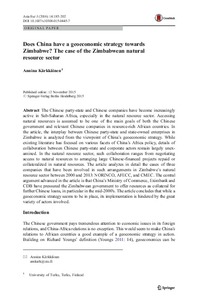Does China have a geoeconomic strategy towards Zimbabwe? The case of the Zimbabwean natural resource sector
Annina Kärkkäinen
https://urn.fi/URN:NBN:fi-fe2021042715644
Tiivistelmä
The Chinese party-state and Chinese companies have become increasingly
active in Sub-Saharan Africa, especially in the natural resource sector.
Accessing natural resources is assumed to be one of the main goals of
both the Chinese government and relevant Chinese companies in
resource-rich African countries. In the article, the interplay between
Chinese party-state and state-owned enterprises in Zimbabwe is analyzed
from the viewpoint of China's geoeconomic strategy. While existing
literature has focused on various facets of China's Africa policy,
details of collaboration between Chinese party-state and corporate
actors remain largely unexamined. In the natural resource sector, such
collaboration ranges from negotiating access to natural resources to
arranging large Chinese-financed projects repaid or collateralized in
natural resources. The article analyzes in detail the cases of three
companies that have been involved in such arrangements in Zimbabwe's
natural resource sector between 2000 and 2013: NORINCO, AFECC, and CMEC.
The central argument advanced in the article is that China's Ministry
of Commerce, Eximbank and CDB have pressured the Zimbabwean government
to offer resources as collateral for further Chinese loans, in
particular in the mid-2000's. The article concludes that while a
geoeconomic strategy seems to be in place, its implementation is
hindered by the great variety of actors involved.
Kokoelmat
- Rinnakkaistallenteet [19207]
